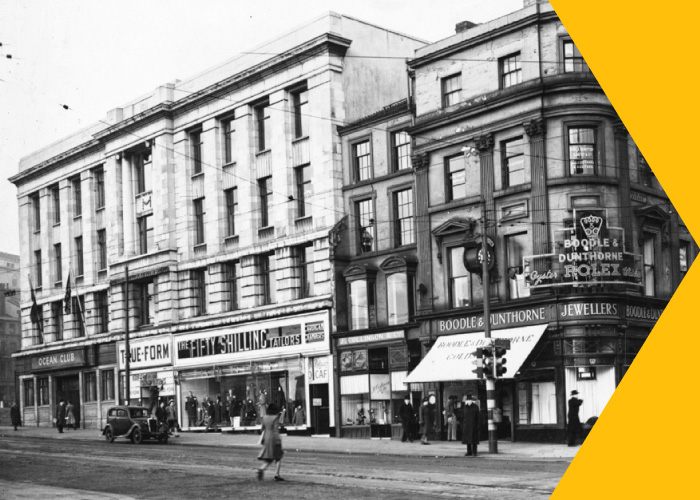There’s just something about the people of Liverpool and our love of local history. With the disruption of lockdown in full swing, it seems that we have never had more time to explore the online world. While live streams and virtual concerts have given us something to look forward to, our Liverpool Record Office team are here to serve us a timely reminder that we have plenty to look back upon too.
The team will be sharing multiple facets of the city’s rich and fascinating history in the coming weeks; from parks to pubs to other places of interest which have cemented their place in the hearts and memories of our people.
We will be updating this section regularly with old (but gold) images from Liverpool in times gone by. Enjoy!
The Changing Faces of Liverpool City Centre
In our first instalment presented by the Liverpool Record Office team, you will find a selection of images highlighting how parts of Liverpool City Centre once looked, along with the year in which they were taken and captions describing each scene.
Liverpool Record Office catalogue numbers are also included should you have a specific interest in one (or all) of the images featured, and wish to follow it up post-lockdown when normal service resumes.
View The Changing Faces of Liverpool City Centre here.
Pubs & Clubs
Over the years, Liverpool has had the fortune to boast a variety of pubs and clubs, renowned for serving up bevvies and smiles in abundance. The Liverpool Record Office team have picked out a few old images displaying a small selection of the city’s favourite watering holes – some of which still exist to this day!
Liverpool’s Dr Duncan – Britain’s First Medical Officer of Health
In recent months we have become much more aware of the role of Public Health in our lives. Professor Chris Whitty, the UK’s Chief Medical Officer, has now taken a prominent role in the media as he advises the government on how to respond to the COVID-19 epidemic in England.
He follows a trajectory begun in Liverpool by Dr William Duncan, the country’s first ever Medical Officer of Health, who took up his newly created role during a deadly epidemic of cholera that killed large numbers of the town’s population. London and other towns followed on, but Dr Duncan was the first who had to fight for often unpopular measures, to change behaviour and improve the environment. Liverpool’s current Director of Public Health is Mathew Ashton, a different title and the role has grown and evolved enormously, but essentially Mathew is a professional successor of Dr Duncan.
View Liverpool’s Dr Duncan – Britain’s First Medical Officer of Health here.
Andrew Carnegie Libraries, Liverpool
Andrew Carnegie (1835-1919) was a self-made Scottish-American industrialist and philanthropist. He came from a poor background and yet at the end of the nineteenth century became one of the richest men in American history. He gave away $350m (around $65bn in 2019 dollars). A good deal of that money was spent building libraries around the world, including in Liverpool. Below are some examples of our city’s Carnegie Libraries.
Liverpool Parks
Merseyside has an important place in the history of urban parks, with both Liverpool and Birkenhead taking pioneering steps in the first half of the 19thcentury. The motivations of park builders varied, from the classic Victorian desire to create ‘lungs’ for the polluted cities, to the hope that building plots surrounding parks could be sold off at a premium. Liverpool’s ring of parks in the inner suburbs was created at an important point in the city’s development protecting significant areas of land that would otherwise have been used for housing in the late 19thcentury, while the scale and design of Birkenhead Park inspired Central Park in New York.
Horses and Carters

Liverpool’s carters and their horses were famous for moving heavier loads than was common elsewhere, yet the men also had a good reputation for the treatment of their animals. The city’s transport system was reliant on horses into the twentieth century, and carters could wield considerable influence in labour disputes as a result.
The Everton FC Collection
The Everton Collection is the largest and most diverse collection of any football club in the UK. It covers the history of football on Merseyside, including when Everton and Liverpool were originally one team known only as Everton, and they played their football at Anfield.
View The Everton FC Collection here.
The Liverpool Record Office team recently contributed to the fantastic piece of film footage below, which shows streetscenes, events and activities taking place in Liverpool in the 1960s. The footage also includes shots of various civic buildings and statues, Otterspool Promenade, Speke Hall, the university refectory and campus, Liverpool Town Hall and several parks and gardens. There’s even interior shots of the Philharmonic Hall, Walker Gallery and Museum, Picton Library and the Cavern club. Enjoy!
While Liverpool Record Office remains closed during lockdown, they are usually open to the public and provide visitors with a chance to access all manner of archive content. The collection, dating back to the 13th century, includes original documents, photographs, maps and newspapers – all of which allow visitors to explore the rich and fascinating history of Liverpool.
Find out more at liverpool.gov.uk/libraries/archives-family-history.
A Complete History of Bluecoat
Beyond Liverpool Record Office, the team at Liverpool City Centre’s oldest surviving building, Bluecoat, have a superb online archive collection, available via My Bluecoat.
There is lots to explore here, including images from the old school, historic documents and collections of posters and programmes. You can revisit a favourite exhibition or discover a new one.










